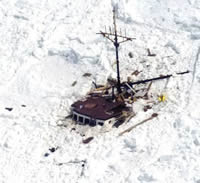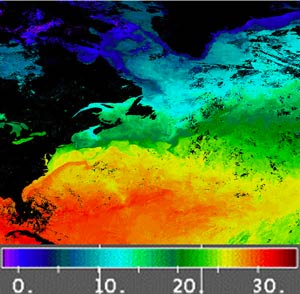It is hard to explain climate science to those who don’t want to know. Yesterday in the House at Question Period, Liberal MP Scott Simms from Bonavista—Gander—Grand Falls—Windsor asked Fisheries Minster Loyola Hearn whether the federal government would provide compensation for people whose boats were lost and whose livelihood was reduced because of the unprecedented level of ice off the east coast of Newfoundland and Labrador.
 I didn’t catch all of the heckling from Environment Minister John Baird, but I distinctly heard him call out “global warming” at the Opposition benches, broad grin affixed to his face, while Minister Hearn attempted to answer the question -- or at least to duck it. Over the dull roar of rudeness that floats up to me in the Diplomatic Gallery it is hard to know what point John Baird was making, but I am quite sure it is not the one I want to share in this blog.
I didn’t catch all of the heckling from Environment Minister John Baird, but I distinctly heard him call out “global warming” at the Opposition benches, broad grin affixed to his face, while Minister Hearn attempted to answer the question -- or at least to duck it. Over the dull roar of rudeness that floats up to me in the Diplomatic Gallery it is hard to know what point John Baird was making, but I am quite sure it is not the one I want to share in this blog.
It is true that there is an unprecedented level of ice off Newfoundland and Labrador. This is most likely not a sign that global warming science is bunk, as some would like us to believe, but actually confirms global climate circulation models. In other words, dangerous thick ice is not inconsistent with climate model projections driven by increasing GHGs.
This is due to the nature of the thermohaline circulation, or put simply, the vast conveyor belt of ocean currents that move all the way around the earth, pulling warmer water up from the Pacific and then diving deep colder water into the Labrador Current. In other words, warmed Gulf of Mexico and Tropical Atlantic currents contribute to colder water off Newfoundland and Labrador.
 You can see it over the years in projections from the global circulation climate models. The “hot spots” are shown in shades of red. The blue dots (fewer of them) represent those places on earth that will get colder as the average global temperature goes up. Cooler water off Newfoundland has been cited as one probable reason the cod stocks are not rebounding despite more than a dozen years of moratorium. (Other scientific research from Dr. Jeffrey Hutchings at Dalhousie suggests that the growth in the offshore oil and gas industry plays a role as seismic tests interfere in cod communication, reducing reproductive success).
You can see it over the years in projections from the global circulation climate models. The “hot spots” are shown in shades of red. The blue dots (fewer of them) represent those places on earth that will get colder as the average global temperature goes up. Cooler water off Newfoundland has been cited as one probable reason the cod stocks are not rebounding despite more than a dozen years of moratorium. (Other scientific research from Dr. Jeffrey Hutchings at Dalhousie suggests that the growth in the offshore oil and gas industry plays a role as seismic tests interfere in cod communication, reducing reproductive success).
No one studying climate science is surprised to see serious ice problems off Newfoundland and Labrador.
Meanwhile, those places where the seals give birth in the Southern Gulf of St. Lawrence are having historically low levels of ice. It is a completely different body of water. The Gulf of St. Lawrence is largely an “inland sea,” with the land masses of New Brunswick, Prince Edward Island, Quebec’s Gaspe, Newfoundland and Nova Scotia encircling this, one of Canada’s most biologically productive coastal zones.
In the southern Gulf, the Labrador Current is not a factor. The ice is disappearing. This has a negative impact on the health of the fisheries including the lobster populations, while imperiling the seal population. Although seal numbers are certainly robust at the moment, as estimates of hundreds of thousands of pup lost to thin ice and washing into the sea and drowning for the last several years (as they are too young to swim), the question of their sustainability as a species is in doubt.
We do need to compensate Newfoundland fishers and sealers now for losses due to ice. We need to set the precedent that climate losses are real.
Question Period often deals with climate costs, disguised as local disaster funding -- the BC pine beetle epidemic, the Fraser River flood programme, the impacts of Saskatchewan flooding, forest fire costs, and on and on.
Climate change brings both fire and ice. Ice is complicated. Climate science it complicated.
It is not something that can be well handled in shouting across the floor in Question Period. Then again, nothing can.